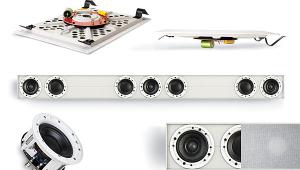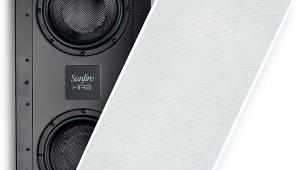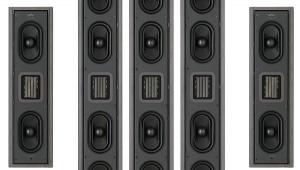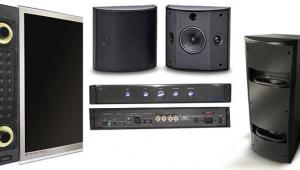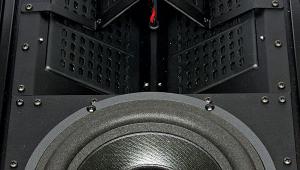BG Radia LA-550 In-Wall Speaker System Page 2
Currently occupying my (otherwise orderly) living room are three BG Radia LA-550 two-way in-wall speakers for the left, center, and right channels. The LA-550 is a hybrid cone/planar speaker with four 5.25-inch bass/midbass cone woofers coupled with six BG Neo8 wideband planar drivers arranged in a line-array configuration. The LA-550 is 73.25 inches tall, 7.06 inches wide, and shallow enough (3.69 inches deep) to fit in a standard residential wall. BG offers and recommends back boxes for the LA-550 ($169 each).
 The SS-303 in-wall bipole surround speaker is a three-way design with two 8-inch woofers. It also houses two BG Neo10 wideband planar drivers and two Neo3 planar ribbon tweeters that face outward at a 45-degree angle to create a diffuse surround soundfield.
The SS-303 in-wall bipole surround speaker is a three-way design with two 8-inch woofers. It also houses two BG Neo10 wideband planar drivers and two Neo3 planar ribbon tweeters that face outward at a 45-degree angle to create a diffuse surround soundfield.
Four BG Radia BGX-S6B inwall subwoofer modules fill in the deep bass. A BGX-A2 power amp with 600 watts times two provides the sub’s power.
For my testing, I mounted the five main speakers in stud-bay-sized enclosures against the walls. I tried several placement options for the subwoofers before I decided to place them against my living room’s side and rear walls.
Heading up the system was a Yamaha RX-V3900 A/V receiver rated at 140 watts times seven. I wouldn’t hesitate to feed the BG Radia speakers more power (lots more, up to 300 watts per channel). But since the speakers have a rated sensitivity of 92 decibels, 140 watts was plenty in my room. To get the best from high-end speakers, you often need to buy new electronics, but the BG Radia LA-550s were quite compatible with the Yamaha AVR.
Cue Up Some Magic
The moment you cue a disc on the BG Radia system, you know you’re listening to a unique loudspeaker and a different kind of sound presentation. One of my first impressions was a heightened sense of transparency and resolution, as if a barrier between me and the music had been peeled away. But that impression went beyond these sometimes overused and vague descriptors. James Taylor’s “Line ’Em Up” from his Hourglass album (stereo SACD, Sony Records) had a sound of stark realism, especially the sound of Taylor’s voice. In truth, I have no idea what Taylor’s voice really sounds like; I’ve never met him or spoken with him. Still, I intuitively know what I expect a human voice to sound like, and his voice sounded natural, uncolored, and stunningly real. It’s as if the speakers and room had disappeared and he was in the room speaking directly to me. It was the same with other vocalists. The delicate and often-elusive details in Melody Gardot’s voice in “Baby I’m a Fool” (CD, Verve Records) were unmistakably clear, as if nothing existed between my ears and her voice.
Transparency, resolution, and a very natural sound quality are standard fare for planar magnetic drivers. The sound is very close to the sound of live musical instruments, particularly acoustic guitar and percussion instruments. The dueling guitars in Chet Atkins and Jerry Reed’s “Vaudeville Daze” (CD, Columbia Records) sounded pinpoint clear and crisp, particularly the guitar riffs.
Human hearing has a finely tuned sense of the differences between live and reproduced sound, and the BG Radia planar magnetic drivers came eerily close to fooling my ear. Musical details sounded crisp, and it was easy to separate various musical elements in the LA-550’s large soundstage. With two-channel sources, the center image was so convincing that I felt compelled to check that the center-channel speaker wasn’t playing.
Audiophiles prefer various characteristics in a sound system, but certainly a palpable sense of realism is near the top of the list.
If a sound system is transparent enough, it will reveal many things about a recording—some good and some maybe not so good. Many audiophiles consider this a badge of honor. A case in point is Koop, a Swedish electronic jazz band that performs an eclectic mix of big band music and Caribbean steel drums, with a dash of Steely Dan–type percussion thrown in. I recently picked up a used copy of Koop Islands (CD, Diesel Music AB) after I heard it on the radio. It’s great music with real toe-tapping rhythms and good vocals. But the electronic nature of the recordings, assembled from digitized music samples, became quickly apparent when I listened to it on the BG Radia system. The sense of space and air you commonly hear from acoustic instruments was noticeably absent. It wasn’t disappointing to listen to; it just revealed the speakers’ capabilities.
Ahhhh, Analog!
My living room is littered with CDs, DVDs, and SACDs I’ve listened to on the BG Radia system, but surprisingly, the most impressive music source I heard was analog. I connected my recently tuned-up Teac reelto-reel deck (circa 1980) and played a few tapes of some classic direct-to-disc LPs I recorded years ago. I recorded them at high speed and played the records wet—a technique where you play the record with cleaning solution on the surface while it’s being recorded. When done properly, this technique lubricates the grooves, eliminates most of the surface noise, and ensures a quiet recording. The tapes sounded so clean, it was easy to mistake them for a high-quality digital recording. The warmth and texture of a good analog recording came through clearly on the BG system.
- Log in or register to post comments



